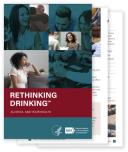Having even a couple of symptoms—which you might not see as trouble signs—can signal a drinking problem. It helps to know the signs so you can make a change early. Doctors diagnose AUD when a person has two or more of the symptoms listed below. AUD can be mild (the presence of two to three symptoms), moderate (the presence of four to five symptoms), or severe (the presence of six or more symptoms). See if you recognize any of these symptoms—or others, such as feeling low, dysphoria, or malaise—in yourself. And don’t worry—even if you have a symptom, you can take steps on your own or with help to reduce your risk of AUD and other alcohol-related consequences. (For more information about AUD, see What Are the Harms?)
In the past year, have you:
- Had times when you ended up drinking more, or longer, than you intended?
- More than once wanted to cut down or stop drinking, or tried to, but couldn't?
- Spent a lot of time drinking, being sick from drinking, or getting over other aftereffects?
- Wanted a drink so badly you couldn't think of anything else?
- Found that drinking—or being sick from drinking—often interfered with taking care of your home or family? Or caused job troubles? Or school problems?
- Continued to drink even though it was causing trouble with your family or friends?
- Given up or cut back on activities that were important or interesting to you, or gave you pleasure, in order to drink?
- More than once gotten into situations while or after drinking that increased your chances of getting hurt (such as driving, swimming, using machinery, walking in a dangerous area, or engaging in unsafe sexual behavior)?
- Continued to drink even though it was making you feel depressed or anxious or adding to another health problem? Or after having had an alcohol-related memory blackout?
- Had to drink much more than you once did to get the effect you want? Or found that your usual number of drinks had much less effect than before?
- Found that when the effects of alcohol were wearing off, you had withdrawal symptoms, such as trouble sleeping, shakiness, restlessness, nausea, sweating, a racing heart, dysphoria (feeling uneasy or unhappy), malaise (general sense of being unwell), feeling low, or a seizure? Or sensed things that were not there?
If you don’t have any symptoms, then staying within the limits provided in the 2020–2025 Dietary Guidelines for Americans could reduce your chances of having problems in the future. If you do have any symptoms, then alcohol may already be a cause for concern. The more symptoms you have, the more urgent the need for change. A health care professional can look at the number, pattern, and severity of symptoms to see whether AUD is present and help you decide the best course of action.
Thinking about a change? The next section may help.
Note:
The questions listed above are based on symptoms of AUD in the American Psychiatric Association’s Diagnostic and Statistical Manual (DSM) of Mental Disorders, Fifth Edition, Text Revision. The DSM is the most commonly used system in the United States for diagnosing mental health disorders.
Previous What are the Harms?
Next Pros & Cons



